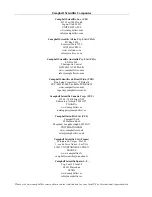
Section 6. Troubleshooting
6-11
14. Reattach the wires to the back of a working RAD modem and plug it into the
computer. Go into terminal emulation mode in TERM and test the system as
explained in steps
7 - 8 in this section.
15. If the system tests out then your wiring has no shorts or opens.
16. If you do not see characters echoing on the screen then possibly the wiring
going out to the datalogger has an open, a short, or is miswired.
Unplug the RAD modem from the computer and remove the wires from it.
Take your meter and set it for low ohms. Measure across the wires that were
connected to "-RCV" and "-XMT". Also measure across the wires that were
connected to "+RCV" and "+XMT". Both measurements should be less than
20 ohms.
If either measurement is shorted, very high, or infinite, then there is a break or
an intermittent connection somewhere in the wiring.
17. Go back to the weather station with your meter set to read low ohms. Untwist
the wires that were connected in step 12 of this section.
Measure across all the wires in any order you want. The meter should read
infinite resistance across any set of wires. If the meter is measuring any
different then you probably have a short somewhere in the line.
A short or open circuit in the line will need to be corrected before
communication between the datalogger and the computer can resume.
Remember to reattach the RAD modems and check the system
again once the line is repaired.
18. If the computer COM port 1, the RAD modems, the cable run, and the
datalogger voltages all check out then the final piece is the SC932C.
Call
Campbell Scientific
.
6.7 Sensor Problems
Sensor problems usually end up being maintenance problems or problems
associated with what was covered in Sections 4 through 6.
6.7.1 Weather Station Maintenance
6.7.1.1 Relative Humidity Sensors
The HMP45C temperature and humidity sensor needs to be calibrated every
two years. This needs to be done at Campbell Scientific.
The sensor uses a temperature sensing PRT that should never need to be
replaced.
NOTE




































